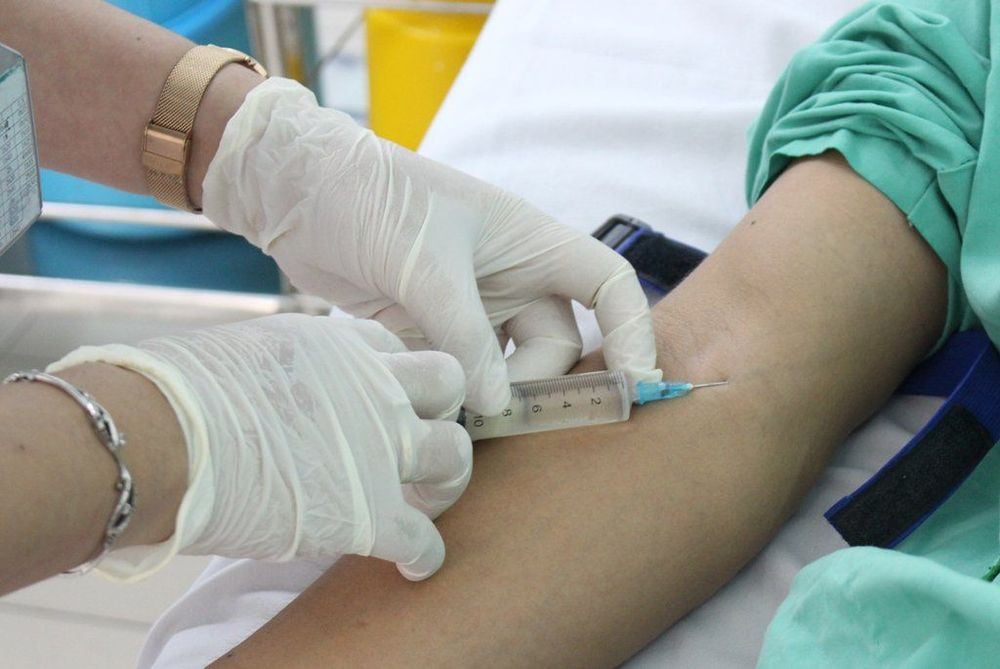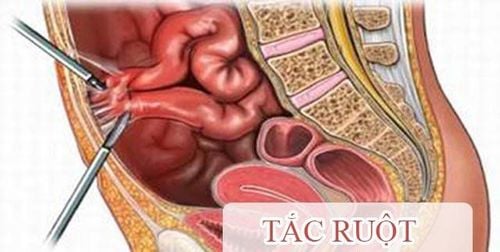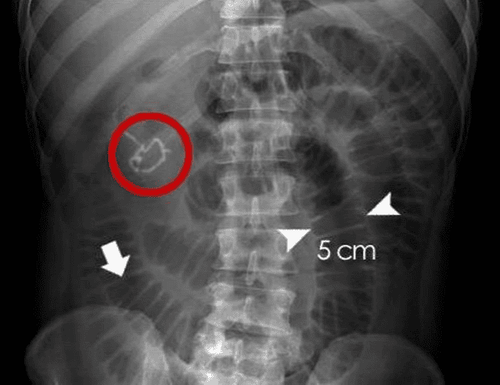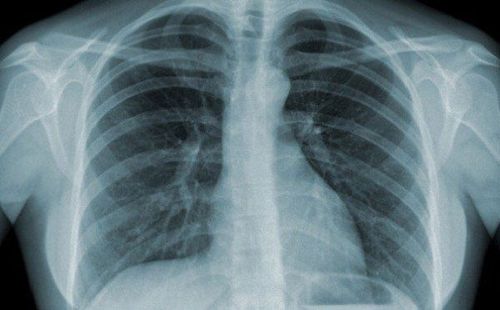This is an automatically translated article.
The article is professionally consulted by Dr. Nguyen Dinh Hung - Diagnostic Imaging - Department of Diagnostic Imaging - Vinmec Hai Phong International General Hospital.
Digital X-ray of the small intestine is a technique to help probe and diagnose diseases in the small intestine such as small bowel inflammation, Crohn's disease, intestinal tuberculosis, ischemic small bowel inflammation, small bowel tumors, small bowel lymphoma, polyps small intestine, adenocarcinoma,...
1. What is a digital x-ray of the small intestine?
Digital X-ray of the small intestine is a technique to increase the contrast of the gastrointestinal tract, also known as contrasting the whole small intestine with contrast agent, Baryt suspension. This technique allows visualization of the entire bowel from the duodenum to the cecum, with moderate distension of the loops, without overlap.
Provided that the x-ray patient must have an enema completely clean before the contrast agent is inserted. For digitizing x-rays of the small intestine, the physician must view under a magnifying screen to see the directions of the loops, use the machine's built-in press or separate to separate the loops or thin the lining to see the mucosa.
2. Indications and contraindications for small bowel digital radiography
Cases with indications for digitizing small bowel x-ray include:
Clinical manifestations of malabsorption syndrome, diarrhea, bleeding or unexplained obstruction. Patients with unclear manifestations such as vague abdominal pain, pain around the navel or pelvis; Vomiting, abdominal distension, no cause found on other techniques. Clinically, there are systemic symptoms, of unknown gastrointestinal origin such as changes in general condition, weight loss, anemia, exhaustion, fever and cough with infectious syndrome. In patients who have had surgery or radiation therapy or even Crohn's disease: Whole small intestine imaging is beneficial to improve intestinal circulation, eliminate food residues, stimulate intestinal tone and motility in some cases reduced tone. The patient has found the cause of obstruction, the bowel is atrophied, the ulcer protrudes from the intestinal wall, the diverticulum or malformation is detected.

Cases of contraindications to digitizing small bowel x-ray include:
Patient is being monitored for intestinal perforation, suspected mesenteric infarction, volvulus Patients with bowel perforation due to duodenal catheter, or in People with Zencker diverticulum or diaphragmatic hernia are at risk of perforation. The technical case is time consuming and uncomfortable for the patient.
3. Preparing for small bowel digital x-ray
Facilities including TV-enhanced x-ray machines, film, cassettes, and storage systems in normal operation should be prepared for digitizing x-rays of the small intestine.
Consumables include:
Oral Contrast Baryt Water-soluble iodinated contrast agent for some cases Air to create double contrast, evenly spread Buryt on mucosa Drugs to increase and decrease bowel motility , hypotonics, anti-bubbles The specialist and radiology technician will directly perform digital x-ray of the small intestine for the patient.

For patients, before taking a small bowel scan, it is necessary to pay attention to prepare:
Have a diet that does not cause backlog for 2 days, do not eat potatoes, fruits, dairy products, drinks steam, can use coffee, tea, fruit juice. The main meals should eat vegetable juice, lean meat, eggs... Stop taking drugs that affect intestinal motility or cause contrast before 12h Use a laxative in the 2 days before, such as Magné Sulfate (7.5g) , Dulcolax, Bodolaxin, Peristatine (2 tablets/day)... Colonic enema with 1.5 - 2 liters of warm water is slowly introduced at a height of 40 cm and kept for 10 minutes; do 2 times a few hours apart or after 12 hours, before taking the scan to avoid reflux of fluid and stool from the cecum into the ileum and jejunum.
4. Technical procedure for digitizing x-ray of small intestine
4.1. Taken through the oral route
Take an abdominal film without preparation in supine, or standing position to rule out contraindications such as intestinal volvulus, intestinal obstruction, intestinal perforation, and at the same time exclude abnormal contrast-enhanced shadows and shadows. For the patient to drink about 300 ml of contrast agent mixed with 30% concentration, it is necessary to monitor under the television light, the route of the drug into the stomach, duodenum. Taken after 20-30 minutes, the patient lies on his back to remove the entire abdomen, size 35x43 cm, with the digital system can be scaled down to 18x24 cm, or 35x43 cm divided into 4 images. If the drug has reached the ileum, intravenous antispasmodic drugs should be administered to reduce peristalsis and facilitate exploration of the intestinal loops. Need to take a series of jejunal films to see the mucosa, then take a scan of the terminal ileum. Usually, the terminal ileum is not enhanced after 30 minutes. Give the patient a second cup of 300ml of contrast agent, wait for another 30 minutes after taking a full abdominal film, if the drug is absorbed into the ileocaecal cavity, end the scan; if still not absorbed have to repeat with third 300ml cup, wait another half hour (total 1 hour 30 minutes) or even fourth time take about 2 hours. The ileostomy can be accelerated as soon as the second cup of the drug with pharmacokinetics - Metoclopramide, or Cholecystokinine mixed into the drug orally or intravenously, or cooling the contrast agent by immersion in ice.

4.2. Colonoscopy through the catheter
The patient lies comfortably on his or her back to allow the catheter to enter the duodenum; It is necessary to explain in detail as during gastroscopy, to prepare psychologically for the patient to cooperate well to put the tip of the catheter into the duodenal frame. If the patient is anxious, a mild sedative can be given by injection or by mouth. Spray anesthetic into the nose, pharynx - the location where the catheter will be inserted. Prepared instruments:
Silicone catheter, impregnated with gel anesthetic. Control the direction of the catheter with a guide wire, the length of the catheter is about 1.2 m, marked in centimeters. Cook's popular catheter is called the Dotte-Bilbao. Guerber - Aulnay's pump controlled fluid flow - Catheterization and injection techniques, taking:
Insert the catheter into the nose, down the pharynx, larynx while the patient swallows, the doctor gently inserts it into the esophagus , stomach. When the catheter is in the cardia, pushing the catheter will pass through the great curvature into the antrum, telling the patient to inhale deeply and slowly, it will be easy to pass through the pylorus and duodenum. Withdraw the lead gradually and continue to thread the tube through the angle of Treitz, then the catheter has a C-shaped opening to the left, inject a little contrast agent to check that it is the duodenum; Secure the cannula to the nostril with adhesive tape. If the catheter does not pass through the pylorus, it will roll up in the antrum. Reinsert the catheter by withdrawing both the catheter and the guide wire until the catheter is straight, pushing the lead a few millimeters out of the catheter. With the patient lying on the left side or standing, we can pass through the pylorus more easily.

Open the valve for the drug to flow into the duodenum according to gravity, or hand pump, pump at a speed of 80-100 ml / min just enough to avoid drug reflux into the stomach. Inject 50ml in batches, monitor the movement of contrast agent through each segment of intestine and take local imaging if necessary. The total amount of contrast agent used is from 900 to 1,500 ml (average 1 liter). Observe under luminosity to see the direction of the loops, use a compression lever to separate the bowel loop or thin the mucosa, until the drug penetrates the terminal ileum. Conduct double contrast generation: inflatable or Methycellulose. Take large-scale film to remove all bowel loops. Localized imaging of the ileocecal region to end the procedure. If the patient has cramping pain or the drug is circulating too quickly through the small intestine, administer Buscopan or Visceralgine intravenously.
5. Evaluation of results
The small intestine digital x-ray results give a clear, complete picture of the anatomical structures of the small intestine, recognizing damage if any.

6. Complications and treatment
In patients with suspected intestinal perforation or obstruction, do not take Baryt contrast agents to avoid complications.
Gastrointestinal X-ray with contrast is an imaging method to evaluate the anatomical structure of the gastrointestinal tract. Therefore, patients should choose reputable medical facilities that have enough modern medical equipment systems to perform this technique.
In order to improve the medical examination and treatment process, Vinmec International General Hospital has now applied gastrointestinal X-ray technique in examination and diagnosis of many diseases. X-ray technique at Vinmec is carried out methodically and according to standard procedures by a team of highly qualified medical professionals, modern machinery system, thus giving accurate results, making a significant contribution to diagnosis and staging of the disease.
Vinmec International General Hospital is a high-quality medical facility in Vietnam with a team of highly qualified medical professionals, well-trained, domestic and foreign, and experienced.
A system of modern and advanced medical equipment, possessing many of the best machines in the world, helping to detect many difficult and dangerous diseases in a short time, supporting the diagnosis and treatment of doctors the most effective. The hospital space is designed according to 5-star hotel standards, giving patients comfort, friendliness, peace of mind in accordance with the spirit: PATIENT CENTRAL like what Vinmec system is building.
Please dial HOTLINE for more information or register for an appointment HERE. Download MyVinmec app to make appointments faster and to manage your bookings easily.














